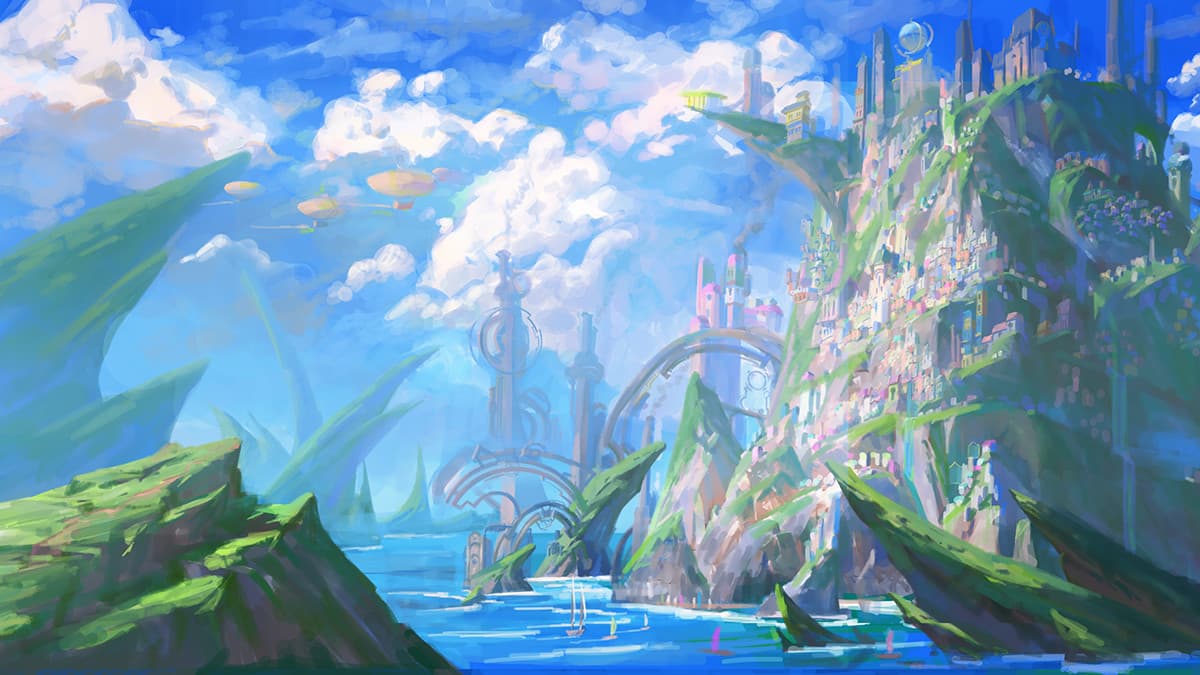
Anthea

Lore
March 6th, 2024
Reading time
The largest peninsula in the Asgarthan Protectorate, located south of the capital beyond the Muir Concordia, is divided into two Provinces: Caer Kettria to the west and Caer Arcolano to the east. Like Enosha, Anthea is considered an agrarian and pastoral territory, and the capital heavily relies on the food resources from this peninsula to feed its population.
![]()
Regions of Caer Kettria
Ifu Cove
The Ifu Cove is an area of the Biela sea shielded from winds and tides. It consists of narrow straits and winding sea arms. Countless waterfalls can be found here, including the majestic Sabaax Falls that encircle the city of Kestia. The bay itself features numerous stacks rising from the waters, or arches projecting into the sea from the towering cliffs.
The Nutsuwa Highlands
The Nutsuwa Highlands are tranquil and serene expanses. They are separated from the Arami Lowlands by a rift, nicknamed the "Scar". Legends say that it was a sword stroke that created this fissure, struck by Rune when wielding Excalibur, as he slew the Tumult Singularity that unfolded in this place. Beyond this boundary, the Highlands are a poetic place, with a cottony atmosphere, perpetually bathed in a melancholic bluish glow. The territory seems constantly illuminated by moonlight. Giant flower forests of poisonous beauty can be found here, as well as seas of pampas grass, swaying their fluffy stems, or forests of pallid trees with ghost-white trunks, under canopies of blue and luminescent foliage. The trees constantly emit a fluffy pollen that falls like snow. The lakes are peaceful-looking, surrounded by beaches of fine white sand. Moreover, all sounds seem muffled here. Within this peaceful setting, numerous silent creatures can be found, ghostly and semi-translucent beings that roam the area like half-incarnated specters.
The Arami Lowlands
The Arami Lowlands are vast expanses of plains and valleys, a sea of grass and wheat that lazily unfolds to the horizon. This particular territory of Anthea, located at the heart of the Peninsula, is known as Asgartha's main granary. It is from here that the bulk of the Peninsula's agricultural resources come, under what looks like an infinite sky. Some strongholds stand atop the hills, but primarily villages, water and windmills dot the landscape. An impressive number of stone swords can be found here, planted in the ground, massive remnants from a giant yet forgotten battlefield. But most impressive are the carcasses of Leviathans, whose bleached bones stretch out of the ground. Pragmatic spirits, the inhabitants of Arami have decorated these bones and established dwellings within them.
Regions of Caer Arcolano
The Kiragata Wetlands
To the north of the red desert, the rest of Caer Arcolano is a wet region, consisting of marshes and rice fields (many of which are terraced). This area is separated from the desert by the Kandu region, a chain of low-altitude mountains with white, rounded ridges. While most of the lands have been populated and exploited for livestock and agriculture, there is a region, in the center of the territory, where humans never venture: the Fagn. This murky bog seems to expand year after year, like an unhealthy tumor. It is said to harbor strange and terrifying things. Muna and Yzmir have settled on the edge of the Fagn to try to freeze its borders. Outside of this peril, the rest of the territory is bucolic and pastoral.
The Sarkans Desert
The Province of Caer Arcolano is largely covered by an immense desert of red sand. Some areas are rugged, traversed by deep canyons of carmine rock. Clusters of living mass, the Kolamusa, a cross between lichen and baobab that could be mistaken for rock, can be found here. The trunks of these beings are hollow. When one digs into their swollen trunks, they access a sort of well that descends into the ground. These gaping holes lead to a titanic underground cavity held in place by the root network, the Hypogea. In this separate world, rivers of milky white waters irrigate the soil, and the roots produce their own bioluminescence.